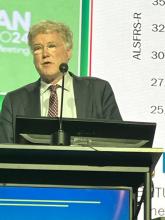DENVER —
As a result, “PB&TURSO is no longer available for new patients in the United States of Canada,” reported Leonard H. van den Berg, MD, PhD, Direction of the Netherlands ALS Center, UMC Utrecht Brain Center, Utrecht, the Netherlands.
Although the drug is now being withdrawn, patients on therapy as of April 4 who wish to stay on treatment “can be transitioned to a free drug program,” added Dr. van den Berg, who presented the results of this new trial, called PHOENIX, at the 2024 annual meeting of the American Academy of Neurology.
PB&TURSO, marketed as Relyvrio (Amylyx), is a combination of sodium phenylbutyrate (PB) and taurursodiol (TAURO). Having shown promise for preventing neuronal death in experimental and early human studies, it was approved on the basis of the of the double-blind multicenter CENTAUR trial published in The New England Journal of Medicine in 2022.
ALSFRS-R Served as Primary Endpoint in Both Trials
In CENTAUR, like the newly completed PHOENIX, the primary outcome was rate of decline in the Amyotrophic Lateral Sclerosis Functional Rating Scale–Revised (ALSFRS-R) over 24 weeks. On this endpoint, the rate of change for those randomized to PB&TAURO was –1.24 points per month versus –1.66 points per month on placebo, a difference of 0.42 points that met statistical significance (P = .02).
The CENTAUR trial, which enrolled 177 patients, also showed no differences between those in the experimental and placebo arms for any of the secondary endpoints, including time to tracheostomy, permanent ventilation, or death.
In the much larger and longer PHOENIX trial, 664 ALS patients were randomized in a 3:2 ratio to PB&TURSO or placebo. Fifty-seven percent in each group completed 48 weeks of follow-up. The proportions of patients who withdrew from the study were similar across the reasons, such as adverse events and disease progression.
For the ALSFRS-R primary endpoint at 48 weeks, the decline in both groups was essentially linear and almost completely overlapped with a final change from baseline of –14.98 points in the PB&TURSO group that was statistically indistinguishable from the –15.32 point-change (P = .667) in the placebo group, Dr. van den Berg reported.
Similarly, there were no clinically meaningful or statistically significant differences in the secondary endpoints of mean change in Amyotrophic Lateral Sclerosis Assessment Questionnaire (ALSAQ-40) scores or mean change in slow vital capacity (SVC) when compared to baseline or between arms.
As in CENTAUR, the most common side effects associated with PB&TURSO were gastrointestinal, particularly diarrhea (31% vs 10%), but serious adverse events were slightly less common on PT&TURSO (26% vs 28%), and Dr. van der Berg characterized the drug as “generally well tolerated.”


